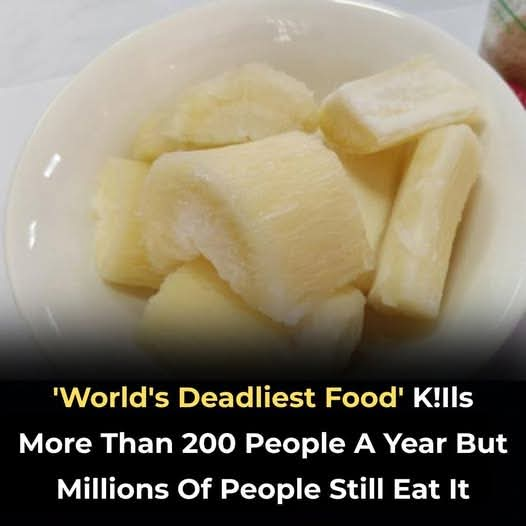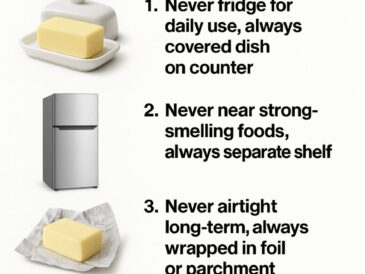Over 200 People Are Killed by the “World’s Deadliest Food” Every Year — But Nearly 500 Million Still Eat It
Every year, a staple food — consumed by hundreds of millions — silently claims more than 200 lives. For many, it’s a dietary necessity. For others, it’s a source of danger.
🍠 The Food in Question: Cassava
The “world’s deadliest food,” as some media outlets call it, is cassava (also known as manioc, yuca, tapioca root). Cassava is a root vegetable that is a primary staple in many countries across Africa, Latin America, and parts of Asia. (LADbible)
According to reports citing the World Health Organization (WHO), cassava poisoning kills about 200 people annually. Despite this, it is estimated that roughly 500 million people worldwide depend on cassava as part of their diet. (LADbible)
Let’s explore why cassava can be deadly, how people get poisoned, and what can be done to reduce the risks.
🧪 Why Cassava Can Be Deadly
Cassava contains compounds called cyanogenic glycosides (notably linamarin and lotaustralin). When cassava is processed—chewed, chopped, or otherwise broken down—these compounds can release hydrogen cyanide, a highly toxic chemical. (Newsner English)
If not properly processed before consumption, cyanide exposure can cause:
- Headache, dizziness, vomiting
- Confusion or even seizures
- Paralysis symptoms
- Respiratory failure
- Death in severe cases
In some survivors, chronic exposure is linked to long-term neurological injuries and conditions like konzo, a paralytic disease affecting the legs. (UNILAD)
🌍 Why So Many Still Eat It
Cassava is hardy, drought-tolerant, and grows well in poor soils, making it a reliable crop in many regions with limited agricultural resources. It serves as an important calorie source in parts of sub-Saharan Africa, rural Latin America, and Southeast Asia.
In many of these places, people may lack access to safer staple foods, or traditional processing methods may be partially degraded due to modern pressures or knowledge loss. Thus, even though there’s risk, the need for food often overrides the danger.
📊 The Bigger Picture: Foodborne Illness & Death Worldwide
Cassava is not the only dangerous food out there. Unsafe food in general poses a major global health crisis:
- Each year, 600 million people fall ill from contaminated food. (Organisation mondiale de la santé)
- Around 420,000 deaths occur annually because of foodborne illnesses. (Organisation mondiale de la santé)
- Children under 5 years old bear a heavy burden — roughly 125,000 of those deaths. (PMC)
Foodborne illness is not evenly distributed. Low- and middle-income countries carry the greatest share of risk because of challenges in food safety infrastructure, regulation, and resources. (PMC)
Additionally, beyond natural toxins like in cassava, many deaths are caused by bacteria, viruses, parasites, chemicals, or poor food handling. (U.S. Food and Drug Administration)
🛡️ How to Reduce Cassava Poisoning — and Food Safety Risks Generally
✅ Safer Cassava Preparation
Many traditional and validated methods reduce cassava’s toxicity significantly:
- Peeling & Trimming – Remove the outer layers where more toxins concentrate.
- Soaking / Leaching – Soak peeled cassava in water so cyanide components leach out.
- Boiling – Boil thoroughly in open pots (so cyanide can dissipate).
- Drying / Sun-drying – After boiling, drying helps reduce residual moisture and degrade toxins.
- Fermentation – Some communities ferment cassava to reduce toxins further.
Promoting, teaching, and preserving these methods is key in communities that rely on cassava.
✅ Strengthened Food Safety Measures
- Implementation of strict food safety regulation and inspection in farms, processing plants, and markets
- Better food hygiene practices: washing, cooking fully, avoiding cross-contamination
- Educating the public — especially in rural or resource-limited regions — about lethal risks of improper food handling
- Monitoring for outbreaks and rapid responses
📰 Real-World Tragedies & Warnings
- Cassava poisonings: The statistic of ~200 annual deaths is often cited in media as the basis for labeling cassava the world’s deadliest food. (UNILAD)
- Outbreaks of foodborne illnesses in many countries from salmonella, E. coli, listeria, and other pathogens also cause deaths and large-scale suffering. (Healthline)
- The 2017–2018 South Africa listeriosis outbreak (from contaminated processed meats) resulted in ~1,060 confirmed cases and 216 deaths — a sobering reminder of the deadly potential of contaminated food. (Wikipédia)
📝 Conclusion
The story of cassava underscores a painful paradox in the world of food: something that sustains life in many regions can also silently kill when mishandled or misunderstood. Over 200 lives lost annually may seem small in global numbers, but for affected communities, each death is avoidable.
More broadly, unsafe food claims hundreds of thousands of lives each year. The solutions are not simple, but they are known: education, infrastructure, regulation, and adherence to traditional knowledge where it works.
By raising awareness, we can encourage safer practices and help prevent unnecessary tragedies.





